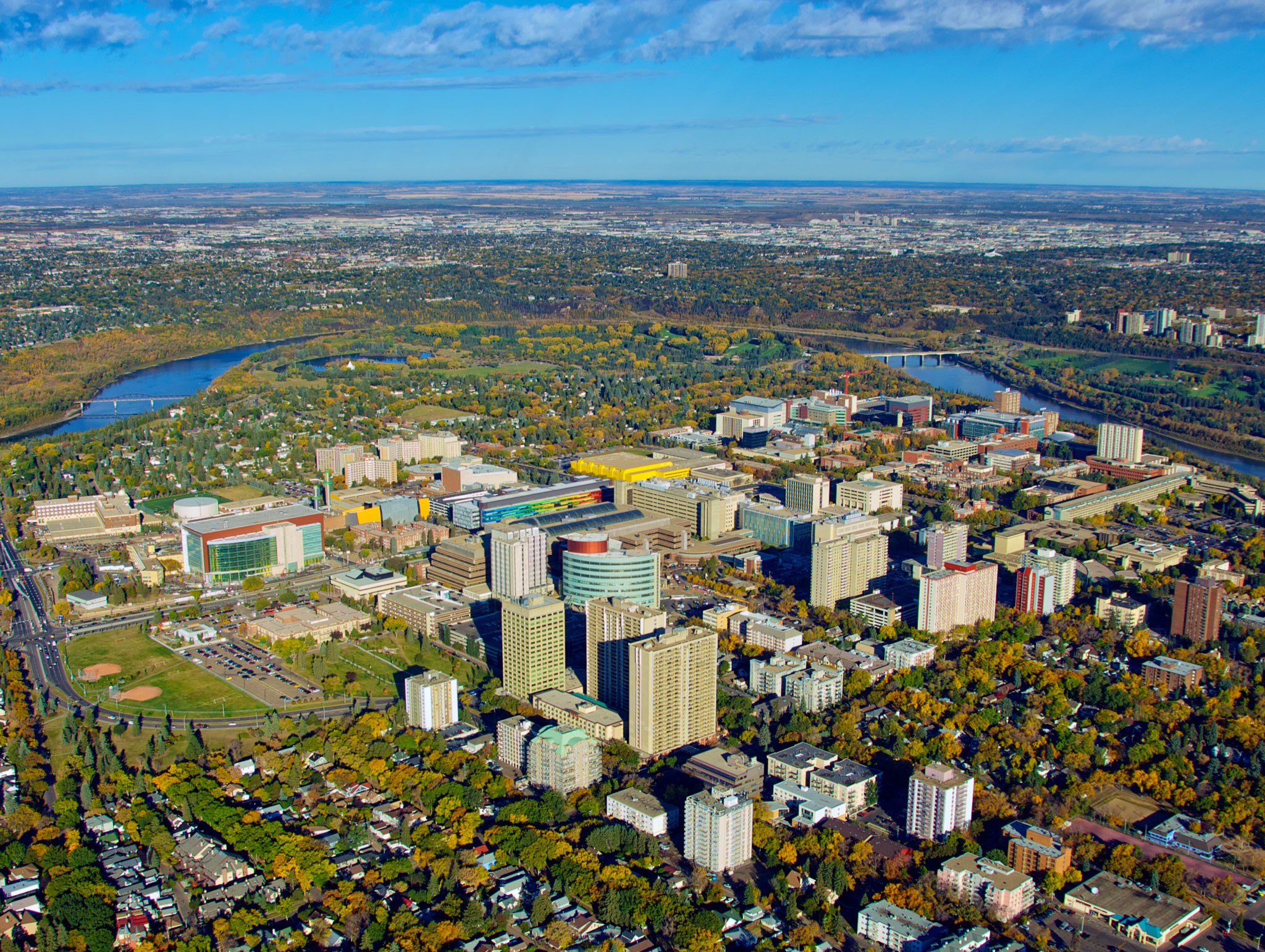
Why has the University of Alberta Board of Governors approved a 4% budget reduction for 2018–19?
A 4% budget reduction was proposed and approved because the University of Alberta faces a number of financial challenges.
First, there is currently a $14M structural deficit in the university’s operating budget. The university has had a structural deficit for a number of years. This deficit exists because budget allocations have been consistently outpacing operating revenues. Spending allocations need to be brought into alignment with revenues.
Second, the university must also manage unavoidable inflationary cost pressures related to our consumption of goods and services ($6M increase), benefits ($6M), and utilities ($2M increase).
And third, the university needs to reduce its reliance on short-term investment income as a source of funding for base operations. Investment income is highly variable and dependent on market fluctuations and is better suited to funding one-time strategic initiatives. For 2018–19, a more conservative investment earnings amount has been budgeted.

If the university has been living with a structural deficit for years, why do we have to deal with it now?
The structural deficit is not only an annual problem; it is accumulating. The university’s accumulated debt in the operating budget is now $157M. To defer addressing the structural deficit would only exacerbate the challenge and defer the problem to future students, faculty, and staff to deal with. To ensure the long-term financial health of the University of Alberta, we need to address the deficit now.
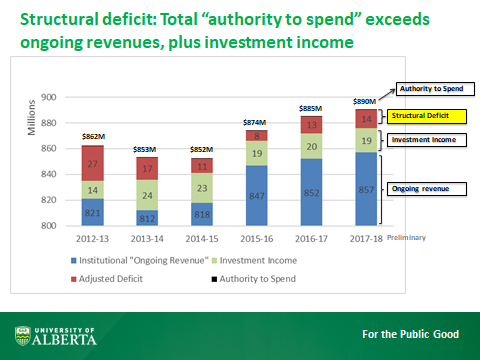
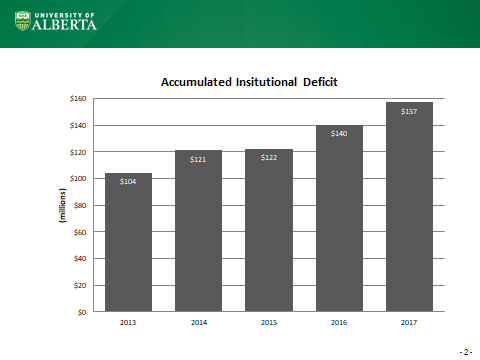
Why is the University of Alberta increasing international student tuition by 3.14% instead of by CPI, which the Graduate Student Association supported?
International student tuition is being increased by 3.14%, rather than CPI, to reflect the estimated increase in costs associated with providing academic programs and student services at the U of A. These costs include increases in salaries, benefits and all the other costs associated with university operations. Our current international fees are below average in comparison to peer institutions.

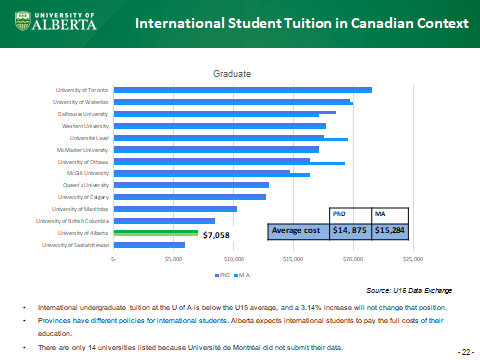
Why won’t the university grandfather in the increase in international tuition so that current students don’t have to pay more than they expected?
We understand that predictability in tuition is important for students as they move through their degrees. At the same time, the university must recover the full cost of educating international students from international tuition, as neither the provincial government grant, nor domestic tuition, can be used to cover the cost for international students.
To both cover costs and grandfather the implementation, incoming students would necessarily face a rate of increase much higher than 3.14%. With grandfathering, incoming students would then subsidize currently attending international students. It was determined that it would be fairest for all international students to pay their share of the increase, rather than asking incoming international students to cover costs for the larger group.
Why are residence fees increasing by 4%?
University of Alberta residences are self-funded. This means that all funds received from students for shelter and food stay within the residence system. As well, no student tuition or government operating funding is invested in residences or dining services. We do not seek to profit from our residences or dining services; however we cannot sustain losses either. The amounts that we charge students to live in residence must cover all of the direct costs of residence operations as well as support capital investments for new residences and residence improvements. There is no other funding source. However, for a number of years, Residence Services has been operating with a deficit and has approximately $90M in deferred maintenance. The increase in residence fees will begin to address this situation as well as to pay for expected cost increases in residence operations. Our residence fees remain below the average of our competitor institutions.
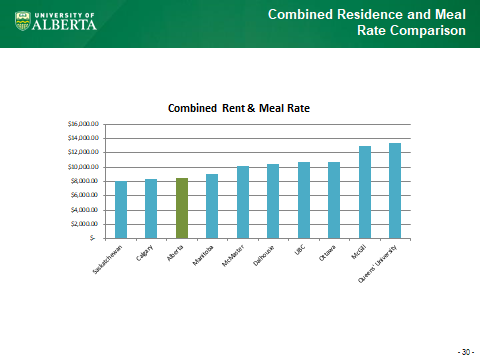
Why is the university increasing meal plan rates?
As with Residence Services, University of Alberta Dining Services must be self-funding both for the direct operational costs as well as capital improvements. Past cost increases have not been sufficient to offset rising costs and support necessary capital investments. These rate increases will start to do this, as well as to allow for the implementation of previously approved “anytime dining” in those residences with the meal plan in place (Lister, Peter Lougheed, and Augustana).
What will be the impact on the recently-approved University of Alberta 2018–19 budget of the 2% increase to the Campus Alberta grant and tuition backfill? (Updated on April 5, 2018)
To fully assess the impact of the 2% increase to the Campus Alberta grant and tuition backfill and determine next steps, we need formal confirmation of the specific funding the U of A will receive. This usually takes the form of a letter from the Ministry of Advanced Education in late spring. However, on an April 4th conference call with representatives from the Ministry of Advanced Education and Treasury Board, members of the U of A’s senior administration team received assurance that, pending passage of the provincial budget, the university will receive the full two per cent increase on our Campus Alberta grant and our full share of tuition backfill. The Ministry and Treasury Board also indicated that there would be no reductions in other aspects of our funding to offset these increases, something that has happened in the past. Based on these assurances and following on preliminary discussions with the BOG at its last meeting, we can now further develop the budget options we had been exploring to determine how additional funding could best be used. Once we receive the formal letter from government confirming our funding situation, we will then be in a position to have more concrete discussions with the Board.
How is the university controlling central administration costs and protecting the academic mission of the university?
The core academic mission of the University of Alberta is our priority, and the operating budget allocations and expenditures reflect this. Compared to Canada’s U15 universities, the U of A has the highest expenditures per full-time equivalent student on instruction and non-sponsored research.
Over the last decade, the U of A’s 18 faculties and schools received a net increase of 67.2% in budget allocations. In the same period, administrative units received a net increase of 39.2%, clearly demonstrating the tighter controls we have applied to these areas. It is important to note that administrative units also provide essential teaching, learning, and research support. Administrative units include:
• Provost’s Office
• IST
• Dean of Students
• Registrar’s Office
• UA International
• Learning Services and Libraries
• Student financial aid and awards
• Research (includes VPR, Research Services Office)
• President’s Office (includes Governance, General Counsel)
• Facilities and Operations
• Finance and Administration
• University Relations
• Advancement
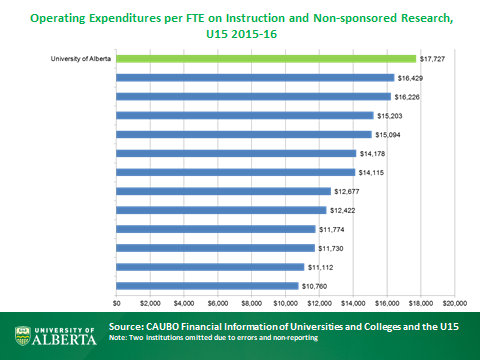
What kind of financial support does the University of Alberta provide to students?
In 2016–17, the University of Alberta provided a total of $105.5 million in financial support to students. Undergraduate students received over $5.7 million in bursaries, and almost $15 million in scholarships. In the same year, graduate students received in excess of $84 million in direct financial support through awards, research assistantships and teaching assistantships, with approximately $44 million of that going to international students. Bursaries to graduate students in 2016–17 totaled $792,000, with $478,000 of that distributed to international graduate students. In 2017–18, another $2M was allocated to student financial support.